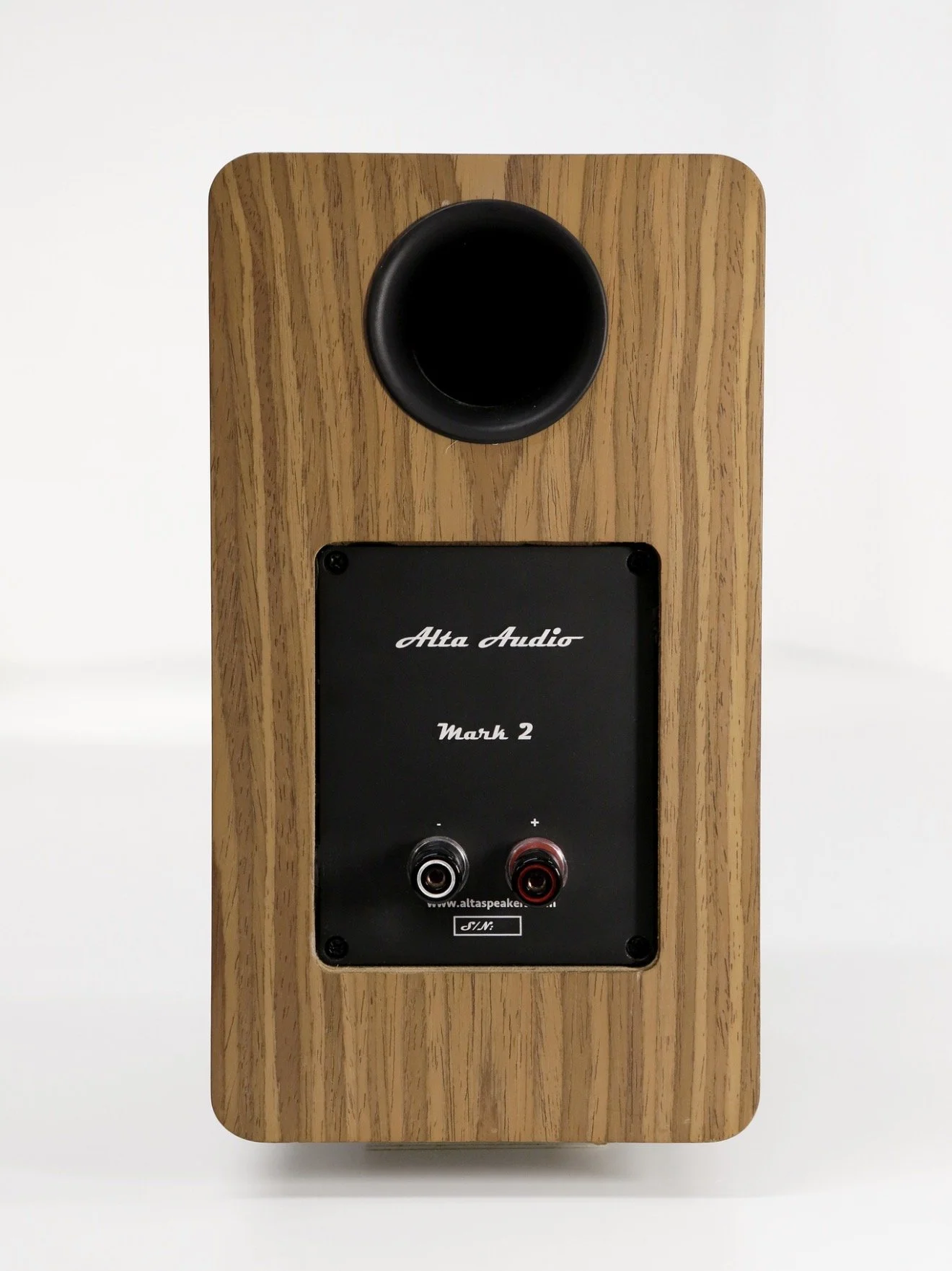Alta Audio Geo Mark II Loudspeaker
Every so often, over 15 years, Michael Levy, CEO/Founder of Alta Audio, would alert me to a new loudspeaker for my perusal. It usually meant something better/more refined in sound quality, with larger/more drivers, and a higher price, or something almost as good at a slightly lower price, but with some of the same fine attributes in sound quality. Most recently, however, I was dumbfounded by something new that I was privy to hear: Alta Audio’s Geo Mark II Loudspeaker, the focus of this review. At USD 3000/pair, it is a 2-driver model that weighs only 17lbs, and with tiny dimensions of 11.875” (H) x 6.5” (W) x 12” (D). Not a bookshelf speaker, it features a bass port; a pair is intended to be placed on stands away from the back wall. They are meant as a serious audiophile quality speaker for smaller spaces, such as in a small apartment living room or a second small space in one’s home. (Before this, the smallest model was the Alto Audio Alyssa, almost twice in size/weight at $5-6K per pair; they can handle a larger room.)
When I first heard them at Levy’s home, in a small back room, right away, I was taken by the large soundstage, excellent imaging, and remarkably deep, well-controlled, clear, and seamless bass, and also the clear/fast high-end response. This so confused me that Levy (correctly) sensed he had to assure me that we were not listening to the pair of his tall Adam floorstanding speakers hovering nearby. So I settled in, listened longer, and ended by arranging for a review pair to come my way soon after; I was intrigued to spend more time with these little siblings in the Alta Audio line. Levy kindly obliged.
Alta Audio’s patented XTL II Bass: a quick overview
Of particular uniqueness in all of the Alta Audio designs is the use of a variation of the Transmission Line (TL) method for handling bass. In general, TL refers to creating a transition line “tunnel” inside the cabinet to channel the sound waves emanating from the back of the woofer to the bass port where they exit. The purpose is to isolate the lowest frequencies, delay them, while the mid and high frequencies are absorbed by the tunnel construction to avoid distortion. The length of the line is about 1/4 of the wavelength of the woofer's resonant frequency, and it is carefully tuned so that only the lowest frequencies are delayed. Moreover, the exit waves from the port are (part of the goal) ensured to be sent out in phase with the waves that come out of the drivers directly in front. But Alta Audio takes it even further by also tuning the cabinet itself (i.e., a hybrid method) to further control any resonances, analogous to how a fine acoustic instrument, such as a cello, is tuned. Alta Audio’s patented “XTL II Bass” is the result, and it received a US Patent on Feb. 27, 2024. It can be found, for example, under the Google Patents website,
Patent US11917361B2: “A method and system of improving frequency responses at lower frequencies from a loudspeaker includes simultaneously tuning a transmission line and a tuned port in the same system. The transmission line and the tuned ports are tuned to the innate characteristics of the physical and electrical components within the loudspeaker. In one embodiment, an improved frequency response of a loudspeaker is achieved by tuning the transmission line to the frequency of the maximum excursion point of the loudspeaker. In another embodiment, the transmission line is tuned to the resonance frequency of the loudspeaker having the tuned port.”
When earlier I had queried Levy about the ability of the tiny Geo Mark II to exhibit such amazing bass performance, and how that baffled me, he was beaming and rightly so; he said, “The Geo Mark II is proof of how well the Alta Audio patented XTL II works.”
How do they look?
They come in two finishes, Matte Black and American Walnut (each the same price, USD 3000). Both are elegant, sleek, and compact; a pair would be a nice-looking addition in a living room. They come with black magnetically connected covers; I kept them off. The cabinet is box-shaped versus the tapered cabinets in the larger Alto Audio models. The 2” dynamic ribbon tweeter and 5.7” midrange woofer are on the front; on the back is the bass port near the top, with a pair of sturdy binding posts near the bottom (banana or spades). Stands are needed, but not ones that require connecting the speakers to them with screws or spikes; any reasonable 26” or so height stands will do; just place the speakers on top. Alta Audio supplied me with a pair of stands for the review. (I reviewed a pair in Matte Black.)
Setting up
My reference speakers are the top-of-the-line Alta Audio Aphrodite, which I bi-wire.
I simply disconnected one cable of the two from each monoblock amp and connected the other one to a Geo Mark II. Experimenting with placement (by listening) was very easy since the speakers are so light and easy to move around, even with stands. I left the rest of my system in place; I used Roon with Qobuz for streaming (or from my own library). I, of course, had to ensure not to let my Aphrodite interfere with the sound (which I kept in place since they are heavy, at about 140lbs each); I even covered each one in front with thick corrugated cardboard. The optimal placement (compared with the Aphrodite) was about 6” closer to each other on either side but within the space between the two Aphrodites, and about 6” closer to my couch (see photo below).
Overall sound quality
The speakers were burned in already, so serious listening was possible immediately. At first, I admit to missing my Aphrodites hooked up; after all, the magnificent Aphrodite, which can shake my apartment with its extraordinary bass, is Alta Audio’s state-of-the-art product (retail, $50,000 a pair USD), a keeper. But after 2 weeks, I got used to the Geo Mark II and was pleased enough to listen without thinking about “when can I hook back up my reference speakers?”. They had the same overall sonic character that is unique to the Alta line. Visitors (not in the know) who had heard my system in the past often assumed (at high volume) that the Aphrodites were connected. They also sounded great at low volumes, too, which is always useful (and pleasant) late at night.
Music
Jerome Sabbagh, “Heart”, Heart, October 2024 (Qobuz, 24/192)
When I first started listening, I was slightly disappointed because the presentation was rigid, left/right with the saxophone on the left, drums on the right, and the bass back/center.
But then it struck me: That is how it sounds live. I had heard the trio, Sabbagh (sax) with drummer and bassist, play live at the Power Station in New York City—an extraordinary, intimate acoustic space—where I had a front and center seat. Sabbagh was on the left, the bassist in the center back, and the drummer more to the right. So, actually, the Geo Mark II was spot on for the soundstage and imaging. Putting that aside, the timbre of the three instruments was superb-sounding. I closed my eyes and enjoyed.
Jerome Sabbagh, Stand Up!, October 2025 (Qobuz, 24/192)
I only add this in here to point out that in this album (Sabbagh’s newest), the imaging is totally different. A quartet now, Sabbagh is with the guitarist Ben Monder, bassist Joe Martin, and drummer Nasheet Waits. The imaging was more diverse: Sax in the middle up high, drums on the right, guitar on the left, bass sometimes on the left, sometimes in the middle; earthy, intimate, and natural sounding through the Geo Mark II, superb recording.
Paul Simon, “One-Trick Pony”, One-Trick Pony, 1980 (Qobuz, 24/96)
Together with the version by Holly Cole from Romantically Helpless, 2000 (Qobuz, 16/44.1)
Oddly, I have listened to Holly Cole’s version so often, and I always knew that it was Paul Simon who composed it and recorded it 20 years earlier—but I never heard Simon’s version.
The Geo Mark II present both recordings admirably, and it was a pleasure to hear the young Simon’s voice, with his rock style; but Cole’s bluesy version shows off the capabilities of the Geo Mark II at its best: The bass alone is stunning; so clear, deep and tight, and with Cole’s voice hovering above in the middle of the soundstage, showing off her rich and sensual contralto.
Schubert: Four Impromptus, Op. 90, D. 899, Eric Lu (May 2025). Warner Classics (Qobuz,24/192). As I was completing my review, American pianist Eric Lu won the 2025 XIX International Chopin Piano Competition in Warsaw (he also won, in 2018, the Leeds International Piano Competition, UK); so I was eager to hear some of his recordings.
I chose Schubert since I have always enjoyed Maurizio Pollini’s playing the late piano sonatas of Schubert; he, too, had won the Chopin competition (in 1980). It started off right away (No. 1 in C minor) with a haunting sustained opening with a loud, low note, descending slowly into a ringing resonance leading to silence. That is all I needed to conclude how well the Geo Mark II can handle the natural sound of a piano. Impressive. I look forward to listening further.
Specifications
Dimensions: 11.875” x 12” (D)
Weight: 17 lbs
Tweeter: 4th generation 2” dynamic ribbon tweeter, with a strong Neodymium magnet, 12mm width reinforced sandwich ribbon diaphram
Midrange/Woofer: 5.7” midrange/woofer, with 2” diameter long throw voice coil using a high-powered motor
Sensitivity: 85.5 dB/2.83 Volts
Frequency response: 34Hz-44kHz +/- 3dB
Impedance: 4 Ohms
Bass: Alta Audio XTL II Extended Transmission Line
Power Requirements: 50 to 100 Watts per channel
Summary
Because of its ability to do so much with so little, the small and inexpensive (USD 3000/pair) Alta Audio Geo Mark II loudspeaker—endowed with the patented XTL II Bass—is a welcome addition to the Alta Audio line. It is undoubtedly an audiophile-quality speaker; I think it will satisfy and fill in the gap for those who only have a relatively small space and want audiophile-quality sound, or want a second system in another small part of their home, such as a study. One could even bring them on a vacation. I must chime in with Levy, by ending with his observation, “The Geo Mark II is proof of how well the Alta Audio patented XTL II works.” A must try. Very highly recommended.
Further information: Alta Audio









